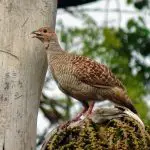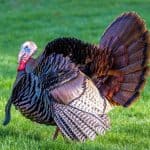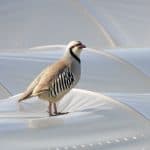Common Name: Japanese Quail
Scientific Name: Coturnix japonica| Size | Diet | Range in Hawaii | Status in Hawaii |
|---|---|---|---|
| 6 in. - 8 in. | seeds, insects, and small invertebrates | Common on all islands | Near Threatened |
Japanese Quail (Coturnix japonica) are small ground-dwelling birds that are native to East Asia. They are known for their distinctive spotted plumage and their ability to lay a high number of eggs.
Japanese Quail have been introduced to many parts of the world, including Hawaii, where they are raised for meat and eggs. In Hawaii, they have established feral populations and are considered an invasive species.
Japanese Quail
Appearance
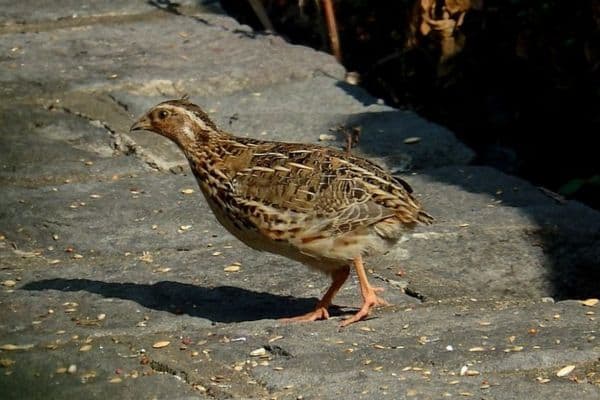
Japanese Quail are small ground-dwelling birds that measure approximately 6-8 inches in length. They have a distinctive spotted plumage, with brown and white feathers on their backs and wings, and white feathers on their bellies.
Males have a darker head and neck than females, and also have a rust-colored breast. Both sexes have a small, pointed beak and a short tail.
Diet
This bird species is omnivores and have a varied diet. In the wild, they feed on a variety of seeds, insects, and small invertebrates.
In captivity, they are typically fed a diet of commercial quail feed, which is high in protein and other essential nutrients. However, they can also be supplemented with fresh greens, fruits, and vegetables.
Japanese Quail are known for their ability to consume a high amount of food relative to their body weight, and can consume up to 30% of their body weight in feed per day.
Behavior
Japanese Quail are social birds that live in flocks in the wild. They are active during the day and spend much of their time foraging for food on the ground.
In captivity, they are often kept in groups and can become quite tame with regular handling. Japanese Quail are known for their high reproductive rate, with females capable of laying up to 300 eggs per year.
They are also fast runners and can reach speeds of up to 12 miles per hour. When threatened, Japanese Quail will often freeze in place or run for cover, rather than flying away.
Nesting
Japanese Quail are ground-nesting birds that typically build their nests on the ground, often in dense vegetation or under cover. Females will lay their eggs in a shallow depression in the ground, which they line with grass or other vegetation.
The eggs are small and speckled, and typically hatch after 17-18 days of incubation. Japanese Quail are known for their high reproductive rate, with females capable of laying up to 300 eggs per year. In captivity, nesting boxes or trays are often provided to encourage females to lay their eggs in a more controlled environment.
Habitat
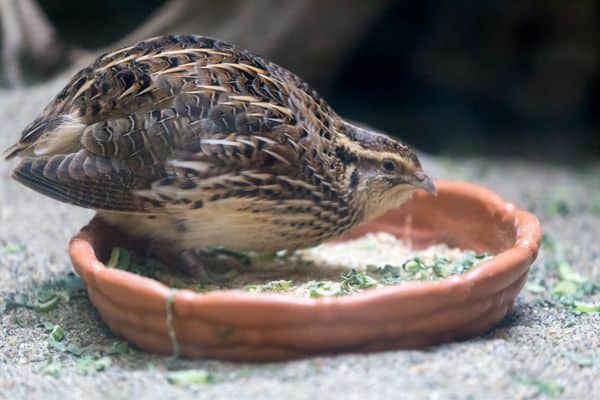
Japanese Quail are native to East Asia and are found in a variety of habitats, including grasslands, farmlands, and forest edges. They are ground-dwelling birds that prefer areas with dense vegetation or cover for nesting and foraging. I
n captivity, they are often kept in cages or pens, but require access to a suitable substrate for foraging and dust-bathing. Japanese Quail are adaptable birds and can thrive in a variety of environments, but are susceptible to extreme weather conditions and require protection from excessive heat or cold.
In many parts of the world, Japanese Quail have been introduced for hunting or egg and meat production, and have established feral populations in some areas.
Range
Japanese Quail are native to East Asia and have a wide range that extends from Russia to Southeast Asia. They have also been introduced to many other parts of the world, including Hawaii, where they are raised for meat and eggs. In Hawaii, they have established feral populations and are considered an invasive species.
Conservation Status

The Japanese quail is currently listed as “near threatened” by the International Union for Conservation of Nature (IUCN). This species is at risk of becoming threatened with extinction due to habitat loss, hunting, and capture for the pet trade. Conservation efforts are necessary to protect and conserve this species.
Although Japanese quails are not indigenous to Hawaii, they were brought to the islands for agricultural reasons. As with any introduced species, there is a potential risk of adverse effects on the local ecosystem. However, the Japanese quail is currently not considered a significant threat to the native Hawaiian species.
While Japanese quails are not native to Hawaii, they have been introduced to the islands for agricultural purposes. As with any introduced species, there is a risk of negative impacts on the local ecosystem, but at this time, the Japanese quail is not considered to be a significant threat to native Hawaiian species.
Interesting Facts
1. Known for their exceptional egg-laying abilities
Japanese quails are known for their exceptional egg-laying abilities, with some individuals capable of laying up to 300 eggs per year.
2. Known for their excellent camouflage
They are known for their excellent camouflage, which helps them to blend in with their surroundings and avoid predators.
3. Relatively short lifespan
They have a relatively short lifespan, with most individuals living for around 2-3 years.
4. They are sexually dimorphic
Japanese quails are sexually dimorphic, meaning that males and females have different physical characteristics. Males have a brighter plumage and a more pronounced crown, while females have a more subdued appearance.
5. They are highly territorial
These birds are highly territorial and will defend their nesting sites fiercely against intruders.
6. Symbols of good luck and prosperity
In Japan, the Japanese quail is known as “uzura” and is considered to be a symbol of good fortune and fertility. It is sometimes used as a motif in art and design, such as on traditional kimono fabrics.
Frequently Asked Questions
1. Are Japanese quails good pets?
Yes, Japanese quails can make good pets for those who are interested in keeping birds. They are relatively low-maintenance and can be quite friendly and sociable.
2. How long do Japanese quails live?
Japanese quails have a relatively short lifespan, with most individuals living for around 2-3 years.
3. Can Japanese quails fly?
Yes, Japanese quails are able to fly, but they generally prefer to run along the ground.
4. How do Japanese quails mate?
Japanese quails are monogamous and typically mate for life. Males will perform a courtship display to attract a female, and then the pair will mate.
5. How do Japanese quails communicate with each other?
They communicate with each other through a variety of vocalizations, including crowing calls, alarm calls, and contact calls.
6. What is the average lifespan of a Japanese quail in captivity?
They can live for around 2-3 years in captivity, although some individuals may live longer with proper care.

